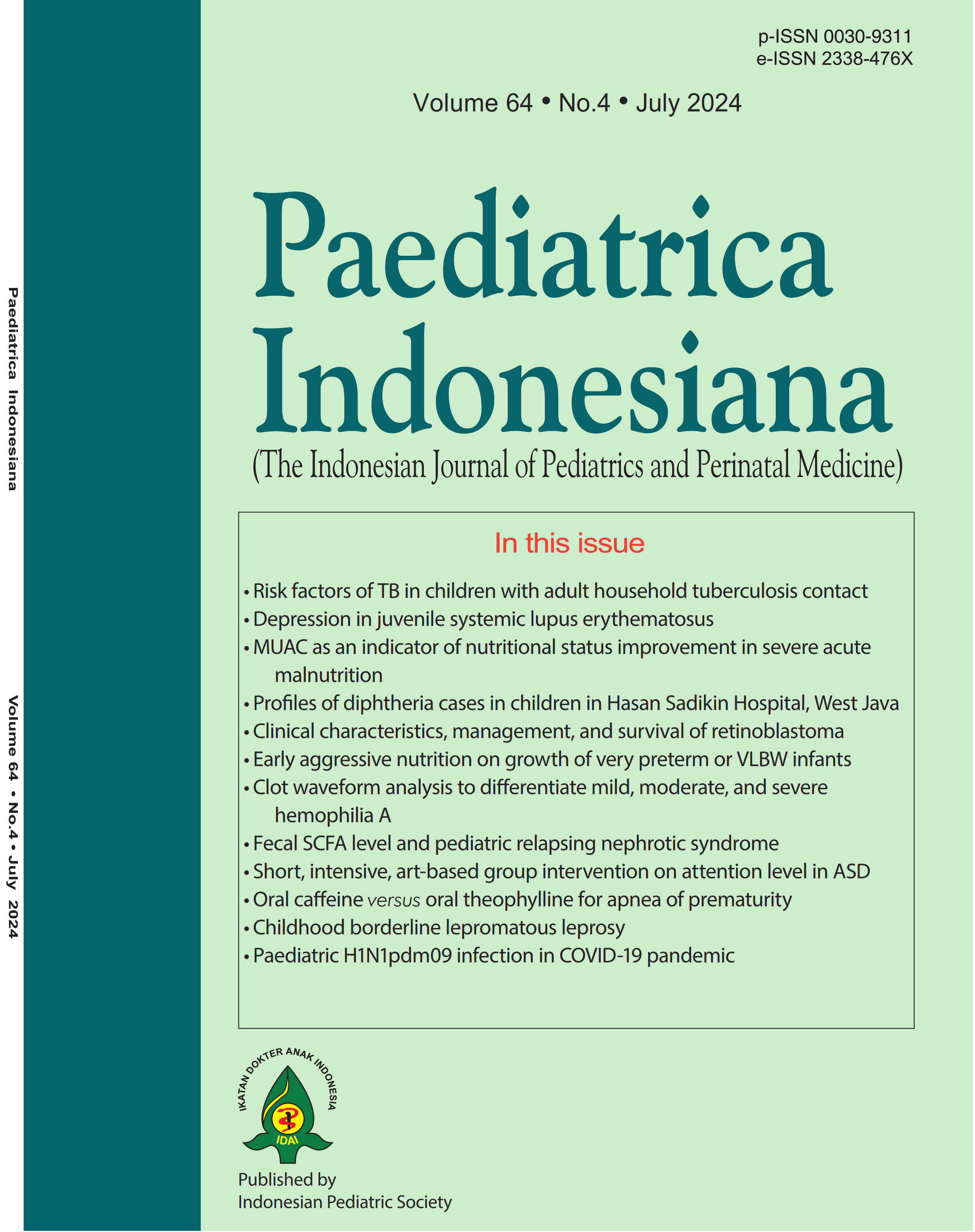Effectiveness of a short, intensive, art-based group intervention on attention level in children with autism spectrum disorders: a pre-post experimental study
Group art-based intervention and attention level in children with ASD
Abstract
Background The rate of autism spectrum disorder (ASD) is dramatically rising globally, especially in the Middle East and North Africa. There has been little research on the effects of art-based interventions on attention impairments among children with ASD.
Objective To examine the effectiveness of a short, intensive, art-based intervention on attention switching and attention to detail in children with moderate-severe ASD.
Methods In this pre- and post-experimental study, children previously diagnosed with levels 2 and 3 ASD were invited to join a one-month, art-based course. The art-based intervention was held 3 days/week for 2 hours per day.
Results The mean age of subjects was 8.33 (range 5 to 11) years; there were 10 (83.33%) males and 2 (16.67%) females. The total Autism Spectrum Quotient (AQ-Child) scores from baseline to one week after completion of the art-based course were not significantly different. In addition, mean social skills scores of attention switching and attention to detail, as well as communication scores were not significantly changed from baseline to after course completion. However, the children had significantly worse median imagination scores after the course compared to baseline scores (18.0 vs. 16.0, respectively) (P=0.0020).
Conclusion After a one-month, art-based, group intervention, AQ-Child scores did not change significantly in total score, social skills, attention switching, attention to detail, or communication. The median imagination score worsened after, compared to before, the intervention. However, these results need to be interpreted with caution due to the very small sample size.
References
1. American Psychiatric Association. Diagnostic and statistical manual of mental disorders DSM-5™. 5th ed. Washington DC: American Psychiatric Publishing; 2013. DOI: https://doi.org/10.1176/appi.books.9780890425596
2. Richard DA, More W, Joy SP. Recognizing emotions: testing an intervention for children with autism spectrum disorders. Art Therapy. 2015;32:13-19. DOI: https://doi.org/10.1080/07421656.2014.994163
3. Kang L, Liu J, Liu Y, Liang W, Yang F, Liu M. Global, regional, and national disease burden of ASD among children under 5 years from 1990 to 2019: an analysis for the Global Burden of Disease 2019 Study. Asian J Psychiatr. 2023;79:103359. DOI: https://doi.org/10.1016/j.ajp.2022.103359
4. Li YA, Chen ZJ, Li XD, Gu MH, Xia N, Gong C, , et al. Epidemiology of autism spectrum disorders: Global burden of disease 2019 and bibliometric analysis of risk factors. Frontiers Pediatr. 2022: 10:972809. DOI: https://doi.org/10.3389/fped.2022.972809
5. Bi W, Wu J, Lin R. Research on the case of art therapy and cognition of autistic children. World Journal of Social Science Research. 2018;5:172. DOI: https://doi.org/10.22158/wjssr.v5n2p172
6. Holmes H. The use of art therapy to address attachment in autism spectrum disorder. 2020. Expressive Therapies Capstone Theses. 316. https://digitalcommons.lesley.edu/expressive_theses/316.
7. Martin N. Art therapy and autism: overview and recommendations. Art Therapy. 2009;26:187-90. DOI: https://doi.org/10.1080/07421656.2009.10129616
8. Schweizer C, Knorth EJ, Spreen M. Art therapy with children with autism spectrum disorders: a review of clinical case descriptions on ‘what works’. The Arts in Psychotherapy. 2014;41:577-93. DOI: https://doi.org/10.1016/j.aip.2014.10.009
9. Allen G, Courchesne E. Attention function and dysfunction in autism. FrontBiosci. 2001;6:D105-19. DOI: https://doi.org/10.2741/A598
10. Keehn B, Müller R-A, Townsend J. Atypical attentional networks and the emergence of autism. NeurosciBiobehav Rev. 2013;37:164-83. DOI: https://doi.org/10.1016/j.neubiorev.2012.11.014
11. Masi A, DeMayo MM, Glozier N, Guastella AJ. An overview of autism spectrum disorder, heterogeneity and treatment options. Neurosc Bull. 2017;33:183-93. DOI: https://doi.org/10.1007/s12264-017-0100-y
12. Auyeung B, Baron-Cohen S, Wheelwright S, Allison C. The autism spectrum quotient: Children’s version (AQ-Child). J Autism Dev Disord. 2008;38:1230-40. DOI: https://doi.org/10.1007/s10803-007-0504-z
13. Carter MJ. Diagnostic and statistical manual of mental disorders. Ther RecreJ. 2014;48:275. DOI: https://doi/book/10.1176/appi.books.9780890425596
14. Schweizer C, Spreen M, Knorth EJ. Exploring what works in art therapy with children with autism: tacit knowledge of art therapists. Art Therapy. 2017;34:183-91. DOI: https://doi.org/10.1080/07421656.2017.1392760
15. Baron-Cohen S. Theory of mind and autism: a fifteen year review. In: Baron-Cohen S, Tager-Flusberg H & Cohen DJ (editors). Understanding other minds: perspectives from developmental cognitive neuroscience. New York, NY: Oxford University Press; 2000. p. 3–20. DOI: https://doi.org/10.1093/oso/9780198524465.003.0001
16. Ozonoff S, Pennington BF, Rogers SJ. Executive function deficits in high?functioning autistic individuals: relationship to theory of mind. J Child Psychol Psychiatry. 1991;32:1081-105. DOI: https://doi.org/10.1111/j.1469-7610.1991.tb00351.x
17. Mottron L, Dawson M, Soulières I, Hubert B, Burack J. Enhanced perceptual functioning in autism: an update, and eight principles of autistic perception. J Autism Dev Disord. 2006;36:27-43. DOI: https://doi.org/10.1007/s10803-005-0040-7
18. Rozga A, Anderson S, Robins DL. Major current neuropsychological theories of ASD. In: Fein D, editor. The neuropsychology of autism. Chapter: Autism Neuropsychological Theory: A Review. Oxford: Oxford University Press; 2011. p.97-122. PMID: 8813299
19. Koo J, Thomas E. Art therapy for children with autism spectrum disorder in India. Art Therapy. 2019;36:209-14. DOI: https://doi.org/10.1080/07421656.2019.1644755
20. Emery MJ. Art therapy as an intervention for autism. Art Therapy. 2004;21:143-7. DOI: https://doi.org/10.1080/07421656.2004.10129500
21. Gabriels RL. Art therapy with children who have autism and their families. In: Malchiodi CA, editor. Handbook of art therapy. New York: The Guilford Press; 2003. p.193-206. URL: https://www.amazon.com/Handbook-Art-Therapy-Cathy-Malchiodi/dp/1572308095
Copyright (c) 2024 Deldar Morad Abdulah, Bayar Mohammed Omar Abdulla, Pranee Liamputtong

This work is licensed under a Creative Commons Attribution-NonCommercial-ShareAlike 4.0 International License.
Authors who publish with this journal agree to the following terms:
Authors retain copyright and grant the journal right of first publication with the work simultaneously licensed under a Creative Commons Attribution License that allows others to share the work with an acknowledgement of the work's authorship and initial publication in this journal.
Authors are able to enter into separate, additional contractual arrangements for the non-exclusive distribution of the journal's published version of the work (e.g., post it to an institutional repository or publish it in a book), with an acknowledgement of its initial publication in this journal.
Accepted 2024-09-02
Published 2024-09-02













